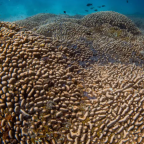
When it comes to abundance of species, nowhere else comes close to the waters between the Pacific and Indian oceans. Nestled between the Pacific and Indian oceans is a marine region deemed to be the richest biologically, in the world. Home to three-quarters of the world’s coral species and over a third of its coral reef fish species, it is the underwater equivalent of the Amazon jungle.
It is half the size of the United States and bordered by six countries – Indonesia, Malaysia, the Philippines, Papua New Guinea, Solomon Islands and East Timor – to form a triangular shape that gives it the name, Coral Triangle.
A new book, The Coral Triangle, by Ken Kassem and Eric Madeja, captures the rich life found above and beneath the water. Published in association with WWF-Malaysia, the book describes the uniqueness of the marine biodiversity, its conservation importance and the effort to keep it intact.
The waters there harbour more marine species than anywhere else on the planet – there are single reefs that contain more species than the entire Caribbean.
Various factors come together to create this biodiversity hotspot: equatorial sunshine; warm, shallow waters; geological features such as deep sea basins and shallow continental shelves; varied habitats; and strong, nutrient-rich currents from the collision of the Pacific and Indian oceans.
This rich habitat, however, is under threat by over-fishing, destructive fishing methods (such as bottom trawling and use of explosives and cyanide), land development, pollution, poaching and climate change. As over 120 million people are dependent on the abundant natural resources of the region, there is reason to protect it.
In 2009, the governments of the region agreed to collaborate on conservation and management measures under the Coral Triangle Initiative. They will conserve the seascape, conduct sustainable fishing, set up more marine protected areas and better manage existing ones, adapt to climate change and address the threats to threatened species.
The efforts of the six countries are highlighted in the book. Malaysia is setting up its largest marine park, the Tun Mustapha Park in northern Sabah. The marine reserve sprawls over 1.02 million ha and encompasses 50 islands. Malaysia will also improve management and stocks of tuna, as well as introduce a certification system for best practices in the live-fish trade.















Social Profiles